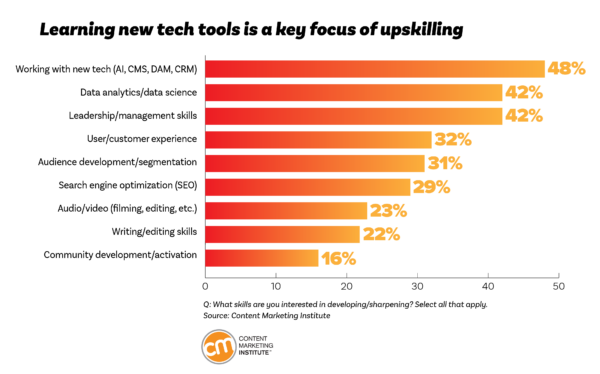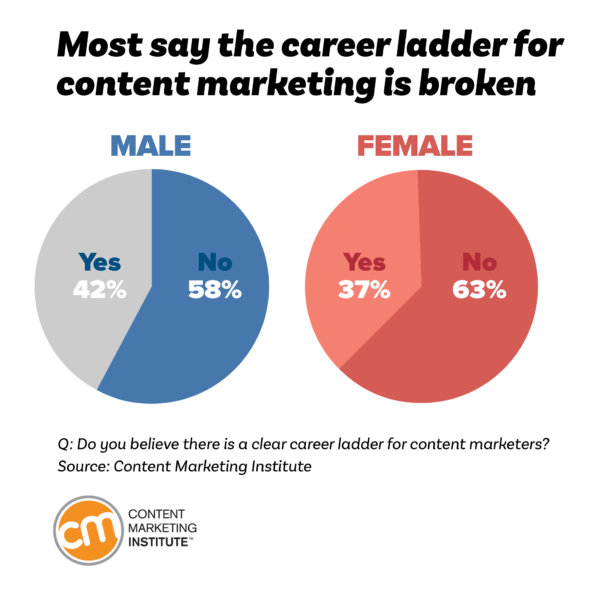MARKETING
Content Marketing Salary 2024 Outlook

Have you felt the AI rip currents pull your career in unexpected directions this year? Many content marketers tell us they have.
When we set out to create Content Marketing Institute’s Content Marketing Career and Salary Outlook for 2024, we decided to quantify AI’s impact on this profession.
More than 1,000 people working in content shared about how much they make, how AI affects careers and compensation, and how they plan to future-proof their skills.
Here’s a sneak peek at some of the key findings:
1. Content marketers make $112,000 a year on average in the United States
That $112,000 average is a healthy figure. Almost half of respondents (47%) say they’re paid fairly.
A #content marketer earns $112,000 a year on average via @CMIContent’s Career and Salary Outlook for 2024 via @EditorStahl. #Research Click To Tweet
How does that compare to your salary? Remember, the average doesn’t tell the whole story. Age, location, role, and gender all affect the number. Register (free) for the full report to see how your earnings compare with others in your area and at your level.
One way to make sure you end up on the higher end of the scale – choose your employer carefully. As one respondent advises:
Make sure you work for a company that values marketing and appreciates its impact on brand awareness and sales. If the company leadership thinks marketing is just pretty pictures, posters, email, and flyers, you will be fighting an uphill battle to get resources, recognition, and promotions.
To find out salary by age, gender, and seniority, download the report.
2. Many use generative AI in their content roles
Content marketers like to explore and test new things – including AI technologies. Three in four surveyed use generative AI tools like ChatGPT or Grammarly on the job.
Nearly half (47%) use generative AI platforms to brainstorm new topics, and 46% use them to research things like headlines and keywords. Twenty-nine percent say they use AI tools to proofread.
Surprisingly, more than one-third (36%) use AI to generate content.
36% of content marketers use #AI to generate content, says @EditorStahl via @CMIContent #Research. Click To Tweet
“AI will be a force multiplier for skilled content creators, reducing effort on lower-value tasks and increasing emphasis on value-add skills,” one respondent explains.
3. But they worry AI will hurt their careers
While many use tools like ChatGPT and Bing Chat, content marketers don’t necessarily feel great about it.
As one respondent says: “I’m very worried. I think our work is already undervalued, and AI will probably only make it worse.”
More than half of writers and editors say inroads from generative AI will commoditize their writing skills and cause them to earn less respect at work. And 46% fear generative AI will drive down their compensation.
46% of content marketers expect generative #AI will drive down their compensation, says @EditorStahl via @CMIContent #Research. Click To Tweet
4. Marketers upskill in ‘AI-proof’ areas; interest in writing skills sinks
Not surprisingly, the No.1 skill content marketers say they want to acquire is learning to work with new technologies (48%) — that’s up two points from the 2023 outlook. Not far behind are improving data analytics/data science skills (42%) and leadership skills (42%).
On the flip side, content marketers are less focused on developing creative skills like writing, editing, video, and audio. A year ago, 40% of respondents said they were interested in honing their writing and editing skills. This year, that figure dropped to nearly half to 22%.
That’s troubling in a profession that relies on talented and creative writers and editors to engage and build trust with audiences. Right now, market forces seem to push content marketers to spend their personal development time on other skills.
But, as legal, intellectual privacy, accuracy, and quality concerns mount, momentum might return in favor of the human team sooner rather than later. Don’t count (or cut) your writers out.
5. People like content marketing work, but concern over career growth lingers
Most content marketers (54%) say they are often engaged at work. Even so, many remain unsure about how to advance in their careers.
Just 25% of marketers say they see a clear path for advancement at their company. (And 75% say they either have to leave their current employer to advance in their career, or they simply don’t see a way to advance.)
Let’s be clear: Career growth is not a problem at the individual level. The issue affects the whole profession – 62% of content marketers say no clear career ladder exists.
Leaders agree: More than half (52%) of people who identify as director level or above say there’s no clear career path for content marketers.
With all the uncertainty caused by generative AI, leaders should work to develop career progressions for their team members or risk losing their most valuable talent.
As CMI chief strategy advisor Robert Rose says, “Any efficiencies AI creates will be undermined if companies need to constantly hire and train new people to oversee complex processes and technologies. Content marketing is a nuanced strategy that requires experience and wisdom.”
HANDPICKED RELATED CONTENT:
Cover image by Joseph Kalinowski/Content Marketing Institute




![How AEO Will Impact Your Business's Google Visibility in 2026 Why Your Small Business’s Google Visibility in 2026 Depends on AEO [Webinar]](https://articles.entireweb.com/wp-content/uploads/2026/01/How-AEO-Will-Impact-Your-Businesss-Google-Visibility-in-2026-400x240.png)
![How AEO Will Impact Your Business's Google Visibility in 2026 Why Your Small Business’s Google Visibility in 2026 Depends on AEO [Webinar]](https://articles.entireweb.com/wp-content/uploads/2026/01/How-AEO-Will-Impact-Your-Businesss-Google-Visibility-in-2026-80x80.png)














